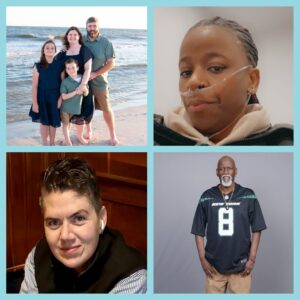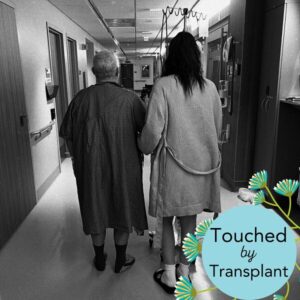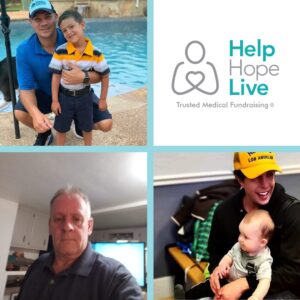Why #MobilityMatters
When you hear the word mobility, what comes to mind?
If you live with a catastrophic injury or illness that impedes your ability to move freely, you already know that mobility is more than just a concept. It’s a word that is closely tied to some of life’s biggest milestones and pursuits.

Living with an injury or illness, mobility can change your life
Each May, we celebrate why #MobilityMatters to thousands of Help Hope Live patients, their families, caregivers, and medical professionals.
When we talk about mobility, we’re referring to far more than walking, reaching, and running. Mobility is a broad term for activities, therapies, and technologies that can add meaning and independence to our lives after injury or illness . Here are some examples.
Mobility is…
…wheelchairs and power chairs that are must-have sources of mobility support.
…physical therapy or exercise-based rehabilitation that increases or helps you to retain your balance, range of motion, and strength.
…home renovations that make it possible to live and move comfortably in your own house.
…accessible transportation that puts careers, college, social events, and medical travel within reach.
…medications and ongoing medical care that safeguard or increase your motion.
Why #MobilityMatters to Me

Paul participates in physical therapy
“Spring is here and we are taking one day at a time with Paul. The steroids have really helped him maintain his abilities, for which we are thankful. Physical therapy sessions in a pool provide good, low-impact exercise for his muscles and lungs.
Paul’s neurologist is recommending a motorized wheelchair with good back support that would be custom-fitted for Paul. A scooter would allow him to be more flexible and it would be easier to transport. We will take time to consider the choices.”
Paul Mustol, South-Central Catastrophic Illness Fund
Living with the genetic disorder Duchenne muscular dystrophy

Molei can regain mobility through therapy
“Molei has been through a lot and survived it all – a near fatal accident, a three-month coma, five months in the hospital, and uncountable setbacks along the way. Her insurance stopped covering her care about four months ago. Now, she is unable to participate in speech, occupational and physical therapy. She can learn to walk, speak, and eat well again, but only with the help of professional therapists.”
Molei Wright, Midwest/West Traumatic Brain Injury Fund
Traumatic brain injury in January 2016

Chris is dedicated to physical therapy and regular exercise
“Chris has been able to go to Craig Rehab for some physical therapy, as well as workouts in their gym. The exercise has been great not only for his body, but for his morale as well.
Chris started a three-month program at Craig Rehab called NeuroRecovery Network (or NRN) which is a program developed by the Christopher Reeve Foundation. In the actual program, they connect him to electrical stimulation while training him to perform various functions. While I was there, they were working on retraining his hands to grasp.
Something that he plans on offsetting through fundraising is an FES bike, which sends electrical currents to the legs as it spins to promote circulation and provide nerve stimulation. He has been using it for 45 minutes to an hour each day, but since his access to outpatient care will ultimately be limited by insurance, having an FES bike at home will help him tremendously. This bike is close to $20,000 out-of-pocket.”
Chris Arbini, Midwest/West Spinal Cord Injury Fund
Spinal cord injury in July 2016

Greater mobility means more independence for Scarlett
“A van would make everyday tasks much easier. My mom had surgery before I started fundraising, and she was on her back for weeks and unable to drive. It would have made such a difference if I could hop in a van and pick up groceries and prescriptions. I want to be able to provide that for my family.
A van would also help me to attend college classes to I can secure employment. I fundraise to offset the cost of the van as well as specialized adaptive driving classes.”
Scarlett Chandler, Southeast Catastrophic Illness Fund
Living with the spinal cord defect spina bifida
Even With Insurance, Mobility Isn’t Free
Mobility-related expenses can become financially devastating to families. In fact:
- Major home modifications for mobility can easily exceed $100,000 out-of-pocket.
- An adapted vehicle could cost you over $50,000.
- Physical therapy may not be covered by insurance at all, leaving you with an out-of-pocket price tag of $20,000 or more annually.
Tell Us Why #MobilityMatters!
We feature your stories and insights on our Blog every year during Mobility Awareness Month. Send your #MobilityMatters stories, pics, or videos to us at [email protected] and you could be featured in an upcoming post. You can take part as a Help Hope Live patient, family member, caregiver, spouse, friend, or medical professional.
Why #MobilityMatters
When you hear the word mobility, what comes to mind?
If you live with a catastrophic injury or illness that impedes your ability to move freely, you already know that mobility is more than just a concept. It’s a word that is closely tied to some of life’s biggest milestones and pursuits.

Each May, we celebrate why #MobilityMatters to thousands of Help Hope Live patients, their families, caregivers, and medical professionals.
When we talk about mobility, we’re referring to far more than walking, reaching, and running. Mobility is a broad term for activities, therapies, and technologies that can add meaning and independence to our lives after injury or illness . Here are some examples.
Mobility is…
…wheelchairs and power chairs that are must-have sources of mobility support.
…physical therapy or exercise-based rehabilitation that increases or helps you to retain your balance, range of motion, and strength.
…home renovations that make it possible to live and move comfortably in your own house.
…accessible transportation that puts careers, college, social events, and medical travel within reach.
…medications and ongoing medical care that safeguard or increase your motion.
Why #MobilityMatters to Me

“Spring is here and we are taking one day at a time with Paul. The steroids have really helped him maintain his abilities, for which we are thankful. Physical therapy sessions in a pool provide good, low-impact exercise for his muscles and lungs.
Paul’s neurologist is recommending a motorized wheelchair with good back support that would be custom-fitted for Paul. A scooter would allow him to be more flexible and it would be easier to transport. We will take time to consider the choices.”
Paul Mustol, South-Central Catastrophic Illness Fund
Living with the genetic disorder Duchenne muscular dystrophy

“Molei has been through a lot and survived it all – a near fatal accident, a three-month coma, five months in the hospital, and uncountable setbacks along the way. Her insurance stopped covering her care about four months ago. Now, she is unable to participate in speech, occupational and physical therapy. She can learn to walk, speak, and eat well again, but only with the help of professional therapists.”
Molei Wright, Midwest/West Traumatic Brain Injury Fund
Traumatic brain injury in January 2016

“Chris has been able to go to Craig Rehab for some physical therapy, as well as workouts in their gym. The exercise has been great not only for his body, but for his morale as well.
Chris started a three-month program at Craig Rehab called NeuroRecovery Network (or NRN) which is a program developed by the Christopher Reeve Foundation. In the actual program, they connect him to electrical stimulation while training him to perform various functions. While I was there, they were working on retraining his hands to grasp.
Something that he plans on offsetting through fundraising is an FES bike, which sends electrical currents to the legs as it spins to promote circulation and provide nerve stimulation. He has been using it for 45 minutes to an hour each day, but since his access to outpatient care will ultimately be limited by insurance, having an FES bike at home will help him tremendously. This bike is close to $20,000 out-of-pocket.”
Chris Arbini, Midwest/West Spinal Cord Injury Fund
Spinal cord injury in July 2016

“A van would make everyday tasks much easier. My mom had surgery before I started fundraising, and she was on her back for weeks and unable to drive. It would have made such a difference if I could hop in a van and pick up groceries and prescriptions. I want to be able to provide that for my family.
A van would also help me to attend college classes to I can secure employment. I fundraise to offset the cost of the van as well as specialized adaptive driving classes.”
Scarlett Chandler, Southeast Catastrophic Illness Fund
Living with the spinal cord defect spina bifida
Even With Insurance, Mobility Isn’t Free
Mobility-related expenses can become financially devastating to families. In fact:
- Major home modifications for mobility can easily exceed $100,000 out-of-pocket.
- An adapted vehicle could cost you over $50,000.
- Physical therapy may not be covered by insurance at all, leaving you with an out-of-pocket price tag of $20,000 or more annually.
Tell Us Why #MobilityMatters!
We feature your stories and insights on our Blog every year during Mobility Awareness Month. Send your #MobilityMatters stories, pics, or videos to us at [email protected] and you could be featured in an upcoming post. You can take part as a Help Hope Live patient, family member, caregiver, spouse, friend, or medical professional.











